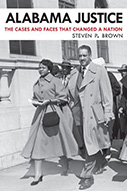Alabama Justice: The Cases And Faces That Changed A Nation

Author: Steven P. Brown
Publisher: Tuscaloosa: The University of Alabama Press, 2020.
Reviewer: Nicholas W. Mason | September 2021
On December 14, 1819, the United States Congress admitted the Alabama Territory to the Union as its twenty-second state. In the 200 years since its statehood, and particularly in the mid-20th century, the State of Alabama has historically been a battleground for racial justice. Civil rights leaders like Rosa Parks, the Reverend Dr. Martin Luther King, Jr., and many others fought to end oppression in Alabama with famous protests such as the Montgomery bus boycott, the marches from Selma to Montgomery, and countless more. Yet fights for racial justice in the mid-1900s that began in Alabama rarely remained confined to the state’s borders; instead, they became intertwined with a national movement for liberation that shook the country’s very foundations. This is especially clear with landmark decisions by the Supreme Court of the United States such as Wallace v. Jaffree (1985), NAACP v. Alabama (1958), and others that began in Alabama before emerging on the national stage.
In celebration of the state’s historical influence on American civil rights with its bicentennial in 2019, Steven P. Brown, Professor of Political Science at Auburn University, co-created a traveling exhibit titled “Alabama Justice: The Cases and Faces that Changed a Nation.” This public history project highlighted a selection of landmark SCOTUS decisions that originated in Alabama and made their way to the nation’s highest court. It was the exhibition’s success in creating public enthusiasm for and interest in these pieces of Alabama and civil rights history, according to Brown, that led to the creation and publishing of this book of the same title.
Alabama Justice: The Cases and Faces that Changed a Nation is a history and examination of eight selected U.S. Supreme Court cases involving the state of Alabama, chosen for their “particular constitutional significance” and “continuing impact on every American.” The author selects eight cases that encompass “religion, criminal law, and racial and gender discrimination,” provides historical context on them, discusses related litigation and rulings, and concludes each case with a discussion of historical significance. The author also examines the careers and legacies of three famous U.S. Supreme Court justices from Alabama: John McKinley, John Archibald Campbell, and Hugo Black. Prefacing his discussion of the individual cases, Brown argues that, due in part to “factors related to timing and culture,” the state of Alabama has historically been at the center of numerous landmark SCOTUS rulings, especially those related to its “unassailably negative” treatment of its Black citizens in the mid-20th century. As Alabamians sought to defend their civil rights with litigation, they used the Supreme Court to transform the federal judiciary into “an agent of social and political change.” Ultimately, although “individual Alabamians” were the ones who defended their rights in the Supreme Court, the author argues that “every American now and in the future is a beneficiary.”
Each of the book’s first through eighth chapters focuses on a different SCOTUS case, and follows the same defined structure: a summary of the case, a brief historical context which the author calls “the story,” a “constitutional background” with legal context for the case, the case’s litigation, the court’s decision featuring text of justices’ opinions, and the author’s conclusions, in which he argues the case’s significance and legacy. Chapter nine is divided into an introduction and three sections, one for each judge whose legacy the author examines. Readers will benefit from the accessibility provided by the author’s thoughtful organization, which breaks down the otherwise complex contexts, proceedings, and implications of each case into an easy-to-comprehend format.
The first chapter, “A Moment of Silence: Public School Prayers and Wallace v. Jaffree (1985),” examines the titular case in which the Supreme Court struck down an Alabama state law “authorizing a moment of silence or prayer in public schools.” In doing so, the court also authorized other moments of silence in public schools for non-religious reasons, and the decision has guided state laws regarding the topic ever since. Chapter Two examines the case of NAACP v. Alabama (1958), in which the SCOTUS reversed an Alabama Supreme Court decision forcing the National Association for the Advancement of Colored People to disclose their membership. Brown argues that this landmark decision explicitly established freedom of association as a right protected under the First Amendment of the U.S. Constitution, and became a precedent for future groups to establish their own anti-regulation claims. The author also argues in the book’s introduction that this “foundation has become less sure” in the twenty-first century with the War on Terror and its associated “increased governmental interest” in Americans’ individual and organizational associations.
Chapter Three examines the case of New York Times v. Sullivan (1964) in which the Supreme Court set forth the “actual malice test” for defamation, protecting the New York Times for publishing an advertisement in defense of Martin Luther King, Jr., that misrepresented the details of certain events. According to the court, inaccuracies alone were not enough to qualify libel. Prosecutors also had to demonstrate the “actual malice” present in the accused party’s intentions. Although the author admits that the decision set a “very high standard” for libel cases, he argues that the founding fathers saw this kind of “uninhibited discourse” as a “necessary by-product of freedom.” The author also connects this decision to the present day, arguing that it was “uniquely relevant” for protecting criticism of the Donald Trump administration.
Chapter Four’s Powell v. Alabama (1932) examines the infamous case of the nine “Scottsboro Boys:” Charlie Weems, Leroy “Roy” Wright, Olen Montgomery, Clarence Norris, Haywood Patterson, Ozie Powell, Willie Roberson, Eugene Williams, and Andy Wright. After being tried in 1931 without adequate legal counsel for the rape of two white women, a crime they were wholly innocent of, eight of the boys were convicted and sentenced to death. The Supreme Court’s declaration the following year that the rights to due process and effective counsel applied to states’, not just federal courts, overturned the boys’ initial convictions. However, even after being retried with better counsel, sadly “the second round of trials largely mirrored the originals.” In 2013, twenty-five years after the death of the last surviving “Scottsboro” defendant Clarence Norris in 1989, Patterson, Weems, and Andy Wright were finally posthumously pardoned, making them the last of the nine to be pardoned or having their charges dropped. Though its ultimate impact on the boys’ lives was limited, Brown argues that the Powell decision has nevertheless “benefited every American facing criminal charges ever since.”
In Chapter Five, the author examines Gomillion v. Lightfoot (1960), and argues that the court’s striking down of redistricting based on race “opened the door” for more litigation regarding anti-democratic policies. The Supreme Court’s decision restored the original city limits of Tuskegee, Alabama after they had been redrawn to exclude most black voters, and overturned the law allowing it. It also set the precedent that the 15th amendment “categorically forbids the denial or abridgement of the right to vote based on race.” Ultimately, however, the issue of political redistricting and gerrymandering “remains an unsolved challenge” for the present day.
The case of Frontiero v. Richardson (1973), which the author examines in Chapter Six, marked the first time SCOTUS struck down a federal law based on gender discrimination. The decision overturned a requirement for women in the United States Air Force to prove dependency in order to claim husbands and children for benefits that men did not have. Although the decision did not elevate gender to the level of “strict scrutiny” for judicial inquiry, the author argues in his brief conclusions that it nevertheless set an important precedent for gender discrimination to be more carefully scrutinized than previously. Chapter Seven examines the decision in Reynolds v. Sims (1964) that upheld an Alabama district court’s order to reapportion its state’s legislative districts. Even though the state constitution required reapportionment based on changing population every ten years, lawmakers had previously refused to do so for over sixty. Like Gomillion v. Lightfoot, the case helped grant Alabama’s black citizens more equitable democratic representation. It also represented SCOTUS’s ongoing expansion of federal power.
The theme of federal expansion for the sake of civil rights continues in Chapter Eight, “Ollie’s Barbecue: The Commerce Clause and Katzenback v. McClung (1964).” According to Brown, SCOTUS’s upholding of the Civil Rights Act of 1964 regarding a small business in Birmingham not only showed the federal government’s authority to enforce it, but also “vastly expanded Congress’s regulatory authority under the Constitution’s commerce clause.” Ultimately, the court used the clause to show how even the individual decision of Ollie’s Barbecue to violate desegregation had national consequences, thus giving it the authority and obligation to intervene.
Finally, the book’s ninth and final chapter reviews the legacies of three SCOTUS judges from Alabama. John McKinley was the first justice to serve in the court’s 9th seat, and helped to bring about “smaller, more equitable circuits” in the original circuit court system before they were abolished entirely in 1911. Although he opposed secession, John Archibald Campbell resigned from the SCOTUS when Alabama seceded from the union in 1861. His arguments in the Slaughterhouse cases eventually set precedent for the federal government to use the 14th amendment to protect unenumerated rights and overturn state laws that infringed on them. Third, Hugo Black’s legal arguments helped to push for “total incorporation” of the Bill of Rights as applied to the states, using the 14th amendment as justification.
The successes of Brown’s book come not only from his comprehensive yet practical examinations of his chosen cases, but also from the important historical lessons he provides. The problem Chapter Three poses of the high standard of libel’s actual malice test versus the founding fathers’ vision of freedom of speech, proves the truly timeless need for critical thinking when it comes to the reading of any primary source. In Chapter Eight, the circumstances surrounding the lawsuit underscore the complexity and pervasiveness of segregation in the period: The restaurant owner himself, Ollie McClung, otherwise did not see himself as a segregationist, but claimed instead to be concerned about jeopardizing white patronage to his restaurant if it became desegregated. The author points out that McClung’s majority black employees who shared profits with the restaurant had “unanimously agreed” to continue segregation in the restaurant for that reason. It is these nuances and others throughout the book, which Brown carefully acknowledges, that paint Jim Crow as not just the actions of a few racist whites, but as a truly evil system of institutionalized racism that influenced every aspect of American life. Its consequences continue to exist in the present day. Alabama Justice reminds readers that progress is never given nor guaranteed, but must always be fought for.
Compared to its achievements, the book’s shortcomings are minor. Although Brown provides many important lessons, he occasionally leaves the reader wanting. His conclusions in Chapter Six are markedly short compared to the others, and readers might not find the case’s legacy clearly spelled out. His occasional lack of follow-up on the connections to current events he mentions, such as with the War on Terror and the Trump administration, may disappoint some readers and weaken his credibility with others.
Like the public history exhibit that inspired it, Alabama Justice the book, is a service to the state of Alabama and to the country as a whole. Although scholars and enthusiasts will not question the importance of studying these cases, Brown shows their continued relevance to all audiences by highlighting their ubiquitous connections to the present. Its educational capacity and accessibility to readers with even just a cursory prior knowledge of the subjects within, ultimately make it a successful book and a valuable part of any curriculum or bookshelf.
Nicholas W. Mason, Ph.D. Candidate, Department of History, Maxwell School of Citizenship and Public Affairs, Syracuse University


